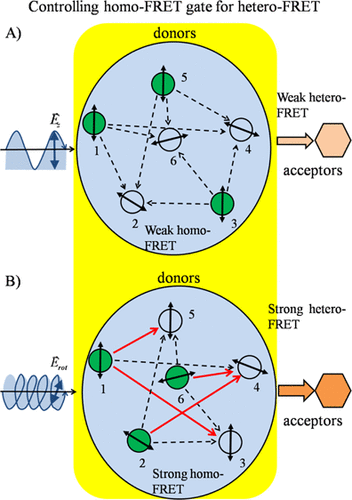当前位置:
X-MOL 学术
›
ACS Photonics
›
论文详情
Our official English website, www.x-mol.net, welcomes your
feedback! (Note: you will need to create a separate account there.)
Fluorescence Resonance Energy Transfer Gating by Elliptically Polarized Light on the Cell Surface
ACS Photonics ( IF 6.5 ) Pub Date : 2021-11-18 , DOI: 10.1021/acsphotonics.1c01135 László Bene 1 , Péter Gogolák 2 , Tamás Ungvári 3 , Miklós Bagdány 4 , Bálint Rubovszky 5 , László Damjanovich 1
ACS Photonics ( IF 6.5 ) Pub Date : 2021-11-18 , DOI: 10.1021/acsphotonics.1c01135 László Bene 1 , Péter Gogolák 2 , Tamás Ungvári 3 , Miklós Bagdány 4 , Bálint Rubovszky 5 , László Damjanovich 1
Affiliation

|
Enhancements of hetero-fluorescence resonance energy transfer (FRET) and homo-FRET have been observed upon excitation with circularly polarized light as compared to excitation with the linearly polarized one in the context of fluorescent dye-labeled cell surface receptors. The enhancement effect has been gradually evolved with changing ellipticity of the exciting light from zero of the linearly polarized light to unity of the circularly polarized one. The measurements have been carried out in a single-laser dual-anisotropy scheme in a flow cytometer, where polarized intensity components in the donor and acceptor channels have been measured simultaneously. For hetero-FRET, the FRET-enhancement effect revealed by a combined detection of donor quenching and sensitized emission of the acceptor has been corroborated by a parallel increase in donor anisotropy and a decrease in acceptor anisotropy. As to homo-FRET, the FRET enhancement, inferred from increased depolarizations of anisotropies measured in two different emission bands, centered at a shorter and a longer wavelength, has also been corroborated by a parallel reduction in “the longer to shorter wavelength” anisotropy ratio. The observed enhancement effects are explained by a relief of orientation mismatch between the FRET donors and acceptors, a phenomenon observable when excitation is depolarized as compared to the linearly polarized one, and a concomitant “homo-FRET-amplified hetero-FRET” phenomenon, both based on an increase in the orientation factor (κ2) for FRET. Circularly polarized light represents a depolarized mode of excitation leading to a photoselected orientational distribution of the donors matching better with that of the potential acceptors. The magnitude of this effect is dictated by the anisotropy of the orientational distributions of the donor and the acceptor. By comparing FRET with excitations of different helicities, a new steady-state method for the detection of molecular dynamics is presented. The method can equally be used in flow cytometers and fluorescence microscopes equipped with excitation with helical light even when the detection is not polarized. The conventional formalism of anisotropy detection in the T-format at vertically polarized excitation has been extended to linearly polarized excitation at different polarization angles and depolarized excitations.
中文翻译:

细胞表面椭圆偏振光的荧光共振能量转移门控
与在荧光染料标记的细胞表面受体的背景下用线性偏振光激发相比,在用圆偏振光激发时观察到异荧光共振能量转移 (FRET) 和同型 FRET 的增强。随着激发光的椭圆度从线偏振光的零到圆偏振光的统一,增强效应逐渐演变。测量是在流式细胞仪中以单激光双各向异性方案进行的,其中供体和受体通道中的偏振强度分量已被同时测量。对于异质 FRET,供体猝灭和受体敏化发射的组合检测所揭示的 FRET 增强效应已通过供体各向异性的平行增加和受体各向异性的减少得到证实。至于同质 FRET,FRET 增强,从以较短和较长波长为中心的两个不同发射带中测量的各向异性的去极化增加推断,也已通过“较长波长与较短波长”各向异性比率的平行减小得到证实. 观察到的增强效果可以通过 FRET 供体和受体之间方向错配的缓解来解释,与线性极化相比,激发去极化时可观察到的现象,以及伴随的“同质 FRET 放大异质 FRET”现象,两者基于取向因子(κ 从以较短和较长波长为中心的两个不同发射带中测量的各向异性的去极化增加推断,也已通过“较长波长与较短波长”各向异性比率的平行减小得到证实。观察到的增强效果可以通过 FRET 供体和受体之间方向错配的缓解来解释,与线性极化相比,激发去极化时可观察到的现象,以及伴随的“同质 FRET 放大异质 FRET”现象,两者基于取向因子(κ 从以较短和较长波长为中心的两个不同发射带中测量的各向异性的去极化增加推断,也已通过“较长波长与较短波长”各向异性比率的平行减小得到证实。观察到的增强效果可以通过消除 FRET 供体和受体之间的方向不匹配来解释,与线性极化相比,激发去极化时可观察到的现象,以及伴随的“同质 FRET 放大异质 FRET”现象,两者基于取向因子(κ2) 为 FRET。圆偏振光代表激发的去偏振模式,导致供体的光选择取向分布与潜在受体的取向分布更好地匹配。这种效应的大小取决于供体和受体的取向分布的各向异性。通过将 FRET 与不同螺旋度的激发进行比较,提出了一种用于检测分子动力学的新稳态方法。该方法同样可用于配备螺旋光激发的流式细胞仪和荧光显微镜,即使检测不是偏振的。垂直极化激发下 T 格式的各向异性检测的传统形式已扩展到不同极化角度的线性极化激发和去极化激发。
更新日期:2021-12-15
中文翻译:

细胞表面椭圆偏振光的荧光共振能量转移门控
与在荧光染料标记的细胞表面受体的背景下用线性偏振光激发相比,在用圆偏振光激发时观察到异荧光共振能量转移 (FRET) 和同型 FRET 的增强。随着激发光的椭圆度从线偏振光的零到圆偏振光的统一,增强效应逐渐演变。测量是在流式细胞仪中以单激光双各向异性方案进行的,其中供体和受体通道中的偏振强度分量已被同时测量。对于异质 FRET,供体猝灭和受体敏化发射的组合检测所揭示的 FRET 增强效应已通过供体各向异性的平行增加和受体各向异性的减少得到证实。至于同质 FRET,FRET 增强,从以较短和较长波长为中心的两个不同发射带中测量的各向异性的去极化增加推断,也已通过“较长波长与较短波长”各向异性比率的平行减小得到证实. 观察到的增强效果可以通过 FRET 供体和受体之间方向错配的缓解来解释,与线性极化相比,激发去极化时可观察到的现象,以及伴随的“同质 FRET 放大异质 FRET”现象,两者基于取向因子(κ 从以较短和较长波长为中心的两个不同发射带中测量的各向异性的去极化增加推断,也已通过“较长波长与较短波长”各向异性比率的平行减小得到证实。观察到的增强效果可以通过 FRET 供体和受体之间方向错配的缓解来解释,与线性极化相比,激发去极化时可观察到的现象,以及伴随的“同质 FRET 放大异质 FRET”现象,两者基于取向因子(κ 从以较短和较长波长为中心的两个不同发射带中测量的各向异性的去极化增加推断,也已通过“较长波长与较短波长”各向异性比率的平行减小得到证实。观察到的增强效果可以通过消除 FRET 供体和受体之间的方向不匹配来解释,与线性极化相比,激发去极化时可观察到的现象,以及伴随的“同质 FRET 放大异质 FRET”现象,两者基于取向因子(κ2) 为 FRET。圆偏振光代表激发的去偏振模式,导致供体的光选择取向分布与潜在受体的取向分布更好地匹配。这种效应的大小取决于供体和受体的取向分布的各向异性。通过将 FRET 与不同螺旋度的激发进行比较,提出了一种用于检测分子动力学的新稳态方法。该方法同样可用于配备螺旋光激发的流式细胞仪和荧光显微镜,即使检测不是偏振的。垂直极化激发下 T 格式的各向异性检测的传统形式已扩展到不同极化角度的线性极化激发和去极化激发。











































 京公网安备 11010802027423号
京公网安备 11010802027423号